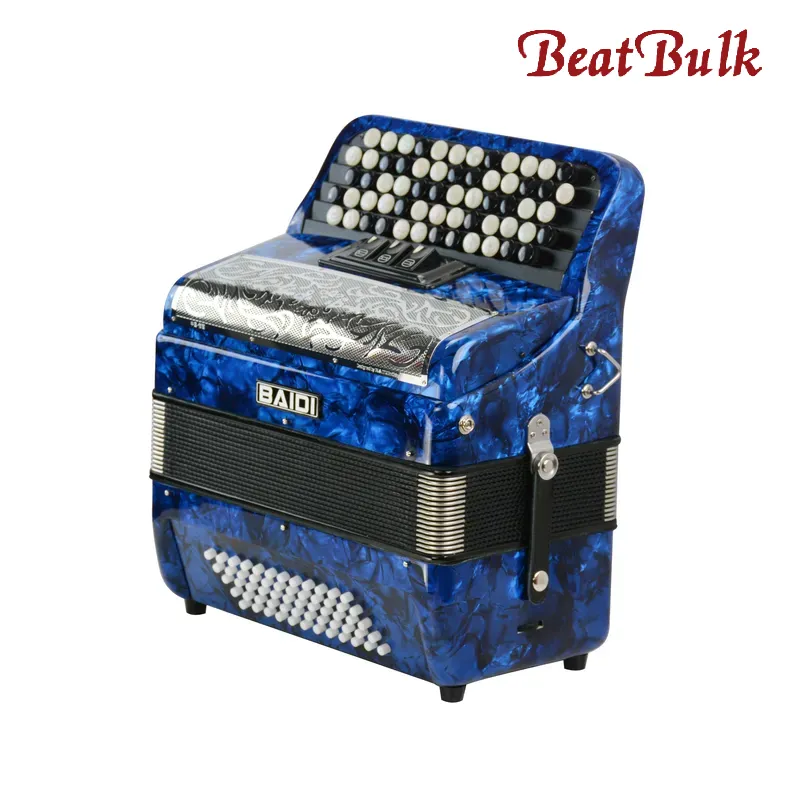Key Takeaways
This guide provides a clear, concise path to choosing the right accordion, whether you’re a beginner intrigued by the simplicity of a button accordion or a seasoned player exploring the complexity of bayans. You’ll discover the key differences between diatonic and chromatic systems to determine which best suits your musical goals. We’ll explore essential features like reed quality, tuning styles (wet vs. dry), and the build of the bellows and casing. To help you make a culturally aligned choice, we connect various accordion types with popular styles such as Tex-Mex, Norteño, and Basque Trikitixa, found across the U.S. and Spain. You’ll also gain practical tips on setting a budget, spotting trusted brands, and testing an accordion before purchase. Whether for performance or personal enjoyment, this guide will help you confidently select a quality button accordion that supports your musical journey for years to come.
Table of Contents
- Step 1: Choose Your System: Diatonic vs. Chromatic
- Step 2: Master Keyboard Layout Choices
- Step 3: Understand Reeds & Tuning
- Step 4: Check Build Quality Carefully
- Step 5: Match the Accordion to Your Music
- Step 6: Navigate the Purchase Process
- Step 7: Test & Secure Your Accordion
- Find Your Perfect Wholesale Partner
- Frequently Asked Questions
- References
Step 1: Choose Your System: Diatonic vs. Chromatic
Your core choice defines the music you’ll play.
Diatonic Button Accordion: Folk Tradition Powerhouse
- Bisonoric design (different note push/pull).
- Ideal for regional styles: Irish, Tex-Mex, Cajun, Vallenato.
- Compact, rhythmic, and key-specific.
Chromatic Button Accordion (CBA): Ultimate Versatility
- Unisonoric design (same note push/pull).
- Full 12-note scale. Plays any genre: jazz, classical, tango, pop.
- Ergonomic button layout for complex music.
Bayan Accordions: Concert-Grade Excellence
- Premium Russian chromatic type.
- Features a converter-free bass system for advanced polyphony.
- Rich, powerful tone for classical/contemporary stages.
- Explore professional bayan accordions here.

| Feature | Diatonic Button Accordion | Chromatic Button Accordion (CBA) | Bayan Accordion |
|---|---|---|---|
| Sound Production | Bisonoric (different note on push/pull) | Unisonoric (same note on push/pull) | Unisonoric (same note on push/pull) |
| Scale | Diatonic (limited to specific keys, e.g., G/C/F) | Chromatic (all 12 notes available) | Chromatic (all 12 notes available) |
| Primary Genres | Folk (Irish, Tex-Mex, Cajun, Alpine) | Jazz, Classical, Tango, World Music | Classical Concert Music, Contemporary, Avant-Garde |
| Left Hand System | Simple bass notes and chords | Stradella Bass (preset chords) or Free-Bass | Converter Free-Bass (switches between Stradella and chromatic notes) |
| Tonal Character | Punchy, rhythmic, bright | Versatile, smooth, can be bright or mellow | Powerful, dark, organ-like, rich in overtones |
| Learning Curve | Conceptually simpler for folk tunes, but mastering bellows control is key | Most demanding due to the converter system and musical repertoire | Most demanding due to converter system and musical repertoire |
| Best For | Players dedicated to a specific folk tradition | Versatile musicians wanting to play multiple genres | Serious classical performers and university-level students |
Step 2: Master Keyboard Layout Choices
Key ergonomics impact playability.
Treble Rows: Range & Flexibility
- 1-2 Rows: Simple folk use.
- 3 Rows: Common in diatonic (e.g., Tex-Mex GCF).
- 3-5 Rows: Standard for chromatic CBAs. More rows = smoother fingering.
Bass Systems: Stradella vs. Free-Bass
- Stradella Bass: Preset chords. Perfect for accompaniment (folk, jazz, pop).
- Free-Bass/Converter: Single-note chromatic bass (left hand). Essential for complex classical on bayan accordions.
Chromatic Layouts: C-Griff vs. B-Griff
- C-Griff: Popular globally (France, Italy). Scale angles inward.
- B-Griff: Dominant in Russia/Eastern Europe. Scale angles outward.
- Choose based on teacher, region, or comfort.
Step 3: Understand Reeds & Tuning
Sound quality hinges here.
Reed Quality Defines Tone
- Machine Reeds: Reliable for students.
- Hand-Finished (Tipo a Mano): Richer tone, mid-level.
- Handmade (A Mano): Best response, dynamics. Found in pro bayan accordions.
Tuning Style: Dry vs. Wet
- Dry Tuning: Reeds perfectly in unison. Clear, focused sound. Ideal for classical.
- Wet Tuning: Reeds slightly detuned. Creates a tremolo effect. Vital for folk styles.
- Musette Tuning: Very wet (3 reeds). Signature French/Italian sound.
Step 4: Check Build Quality Carefully
Inspect before investing.
Materials Signal Longevity
- Solid wood casing (mahogany, alder) beats plastic.
- Deep-fold, reinforced bellows last longer.
- Metal mechanisms > plastic for durability.
Test for Quality Assurance
- Air Tightness: Bellows shouldn’t move easily when closed/no keys pressed.
- Action: Buttons must respond smoothly, quietly.
- Sound: No buzzing/rattling. Notes speak clearly.
New vs. Vintage: Pros & Cons
- New: Warranty, reliability, modern specs. Best for serious players.
- Vintage: Potential character/value but needs expert vetting. Risk of hidden repairs.
Step 5: Match the Accordion to Your Music
Align the instrument with the goals.
Folk & Traditional Players
- Choose diatonic button accordions specific to your style (e.g., 3-row GCF for Tex-Mex).
Classical & Concert Performers
- Bayan accordions with free bass are essential. Demand precision and power.
Versatile Genres & Styles
- A chromatic button accordion (CBA) with Stradella bass offers maximum flexibility.
Step 6: Navigate the Purchase Process
Plan your buy wisely.
Set Your Accordion Budget
- Beginner Diatonic: $400-$1,500.
- Beginner Chromatic: $1,000-$3,000.
- Pro Diatonic: $1,500-$5,000+.
- Pro CBA/Bayan: $3,000-$25,000+.
Trusted Accordion Brands (2025)
- Diatonic: Hohner, Gabbanelli, Castagnari, Saltarelle.
- Chromatic/Bayan: Pigini, Bugari, Scandalli, Jupiter, Weltmeister.
Buy from a Specialist
- Expertise matters. Find a dedicated accordion dealer.
- They ensure setup, offer support, and guarantee quality for your button accordion for sale.
Step 7: Test & Secure Your Accordion
Final checks seal the deal.
Test Play Thoroughly
- Check comfort, weight, and balance.
- Test air tightness, button action, and reed response (soft/loud).
- Listen for an even tone and try all registers.
Get Essential Accessories
- Hard Case: Vital protection.
- Padded Straps: Essential comfort.
- Bellows Protector: Prevents wear.
Commit to Ongoing Care
- Store properly (case, upright).
- Avoid extreme temps/humidity.
- Schedule professional servicing every few years.
Find Your Perfect Wholesale Partner
Ready to stock exceptional button accordions or premium bayan accordions? BeatBulk offers curated wholesale selections for brands, distributors, and schools. Explore our range and competitive bulk pricing today.
Discover Wholesale Opportunities Now: Contact BeatBulk Sales
Frequently Asked Questions
1. What is the main difference between a button accordion and a piano accordion?
The most fundamental difference lies in the right-hand (treble) keyboard. A piano accordion has a keyboard arranged exactly like a piano, which can be intuitive for those with prior piano experience. A button accordion has a field of buttons. This button layout is far more compact, allowing a player’s hand to cover a much wider range of notes with less movement. This ergonomic efficiency is a primary reason many virtuosos prefer the button accordion. Additionally, many button accordions, specifically diatonic ones, are “bisonoric,” meaning a single button produces two different notes on the push and pull of the bellows, a feature not found on piano accordions.
2. How difficult is it to learn the button accordion?
The difficulty is often misunderstood. For some, learning a diatonic button accordion for a specific folk genre can be more intuitive than a piano accordion because the fingering patterns for tunes in the instrument’s home keys are very logical. The main challenge is mastering the bellows push-pull coordination. For the chromatic button accordion, the initial challenge is learning the new button layout, which is not based on a visual piano pattern. However, once the layout is understood, many players find it ergonomically superior and faster than a piano keyboard. The difficulty is less about the instrument being “harder” and more about which system of logic—visual piano or patterned buttons—is more intuitive for the individual learner.
3. Can I play any style of music on a button accordion?
This depends entirely on the type of button accordion. On a diatonic button accordion, you are largely limited to the keys the instrument is built in, making it perfect for specific folk genres but very difficult to use for jazz or classical music. Conversely, a chromatic button accordion (CBA) or a bayan is designed for versatility. Since it contains all twelve notes of the chromatic scale in a unisonoric system, you can theoretically play any style of music, from complex classical literature and improvisational jazz to any form of world music. The choice of instrument directly determines its musical flexibility.
4. How much should I expect to spend on my first good-quality button accordion for sale?
Set a realistic budget for your first quality instrument—something you won’t outgrow too quickly.
- Diatonic button accordion (suitable for both learning and performing): Expect to spend between $1,000 and $3,000.
- Chromatic button accordion (entry-level but good quality): Typically ranges from $2,000 to $5,000.
Why spend more?
- Higher-quality reeds
- More reliable mechanics
- Superior construction
These factors contribute to:
- A smoother and more enjoyable learning experience
- A longer-lasting instrument that grows with your skills
Cheaper options exist, but they often sacrifice playability and durability.
5. What does “dry” or “wet” tuning mean, and which is better for me?
“Dry” and “wet” refer to the tuning of multiple reeds that sound for a single note. In dry tuning, the reeds are tuned to the same pitch, creating a clear, strong, and focused sound that is ideal for classical music and some folk styles, such as Irish music. In “wet” tuning, one reed is tuned slightly sharp compared to the other. This creates a shimmering, vibrating effect called tremolo. A slight detuning is called “swing,” while a more significant detuning creates the classic, vibrant “musette” sound of French and Italian music. Neither is “better”—it is an aesthetic choice. If you want to play classical music, choose dry tuning. If you love the sound of Parisian cafe music, you need wet (musette) tuning. Many versatile instruments offer both options via register switches.
References
- Accordionists.co.uk. (n.d.). The History of the Accordion.
- The Editors of Encyclopaedia Britannica. (2024). Accordion. In Encyclopædia Britannica.
- Kshanti, J. (n.d.). The Bayan, a Russian Folk Music Instrument. The Classical Free-Reed, Inc.
- Liberty Bellows. (n.d.). About Accordions.
- New World Encyclopedia contributors. (2023). Accordion. In New World Encyclopedia.
- Sachs, C., & Shetan, B. (2001). Accordion. In Grove Music Online. Oxford University Press.
- Sheehy, D. (2015). The Sounds of California: The Norteño Accordion. Smithsonian Folklife.







